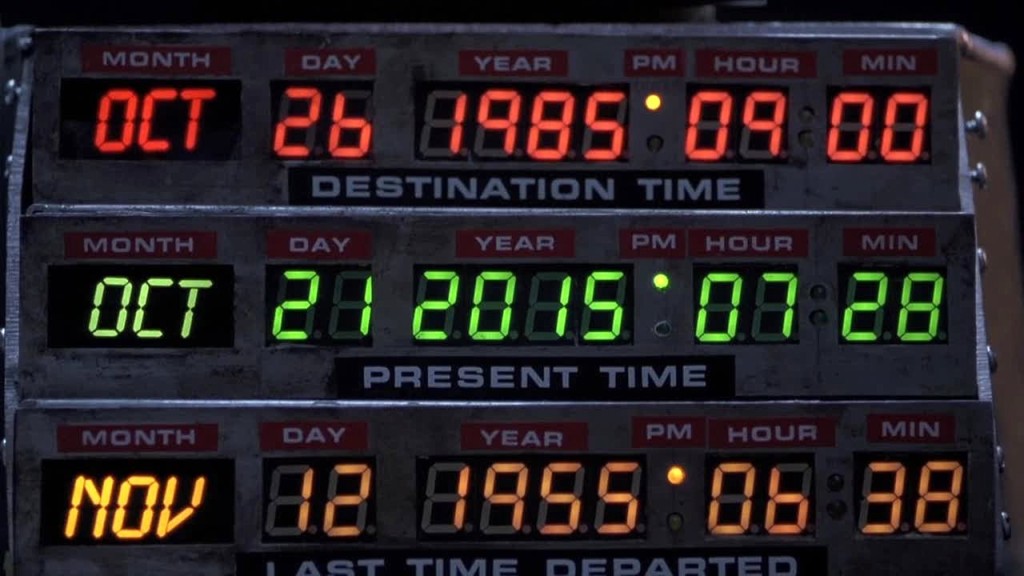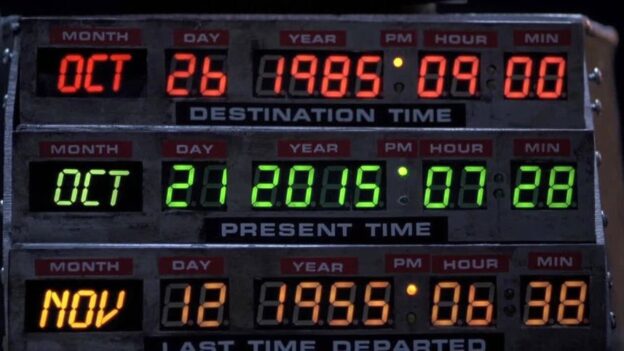Hello listeners, welcome to Luke’s Film Club, this is one of those episodes of Luke’s English podcast in which we focus on a classic moment from the movies. This one is an episode about Back to the Future, which is one of my all time favourite films and I’m not alone because it’s one of the most popular films of the last few decades, all over the world. It’s a really entertaining and fun film, which also contains some sub-texts related to the complexities of time travel as well as a few visions of the future. Also, in the film’s sequel, the main characters Marty McFly and Doc Brown end up travelling into the future – and to what date? October 21, 2015. That’s today (when recording this). So it seems to be the perfect moment to do an episode of Luke’s Film Club, devoted to this modern classic. This is basically international Back to the Future day, and there’s only one! So, this has to be the day on which I record this episode.
 [DOWNLOAD]
[DOWNLOAD]
In this episode I’m going to talk about these things:
- When I first saw it and what it means to me
- The plot of the film (quite a challenge actually)
- Themes of the film and lessons we can learn from the story
- Some bits of info or things you might not have known about the film
- The films predictions of 2015 – how many are correct?
- How does the DeLorean time machine work?
- Is time travel possible?
- What about paradoxes created by the film’s time travelling story?
Ironically, time will definitely be a factor in this episode, because it will be hard to squeeze all of that into an hour. Let’s see what happens. It’s probably going to be another 2 part episode or something. But Back To The Future is a great film isn’t it? Come on, it’s great. It’s really popular all over the world, it’s really fun and interesting. Let’s talk about Back to The Future, however long it takes.
UPDATE: In part 1 of this episode I only talked about points 1 and 2 in the agenda above. The plot of Back To The Future 1-3 is pretty complicated and takes some time to describe! The rest is covered in the next episode.
SPOILER ALERT!
I’m going to mention some parts of the plot in this film. So, if you haven’t seen it before then I will probably give away some of the surprises in the story. I’m assuming that the vast majority of you have seen this film. It’s one of the most popular films of the last few decades, but I’m sure some of you haven’t seen it. Just be aware that I will probably reveal some fairly big plot details in this episode, so you might want to watch the film before listening to this episode.
Saying that though, I think it’s quite hard to truly spoil the film, just because there are many things about it that make it exciting. I’ve seen it (and the sequels) lots of times, and I enjoy it more and more every time, even though I know exactly what’s going to happen next. It’s so well-directed that it’s always exciting. But anyway – watch out, there are spoilers ahead.
I’ve been trying so hard for ages to find a way to properly cover the subject of this film in a podcast. It’s very hard! There’s so much to say! The storyline of the film is pretty complex, and the themes of time-travel, family, future technologies and controlling your destiny are really big things that deserve a lot of attention. So, I’m not sure I can squeeze it into just 1 hour of chat. This may end up being two episodes – but you don’t mind do you? Why would you mind? This could be a 5 minute video on YouTube, like “The 5 best moments from Back to the Future” but I want to go into more depth, and get sidetracked by themes of technology and time travel, so it will just take as long as it needs. In fact it’s a bit ironic that I’m talking about time limitations when this is a film about time travel, and the complexities which surround it. Essentially, I’m going to focus on the subject first, and if that means it’s a long episode, then so be it. In fact, since this is a podcast you have some control over time and you can skip forwards in the episode, backwards in the episode or simply freeze time completely by pressing the pause button, and then start it again later. You’re in control of time, essentially. I’ll just focus on making the content and you can choose how to listen to it. :)
Also, there are other films/books I could have talked about: HG Wells: The Time Machine, The Terminator, Looper, Bill & Ted’s Excellent Adventure, Interstellar. But, this one is all about BTTF! So let’s go.
1. When did I first see it and why do I like it?
– As a kid, with my Dad.
– I was 8 years old, my brother 10.
– We saw lots of really great films in the Ealing cinema around this time, including Return of the Jedi, Indiana Jones & The Temple of Doom, Flight of the Navigator, Back to the Future, The Goonies, E.T. and more…
– I actually managed to understand what was going on, and I found it incredibly fun and exciting.
– Cereal box, with the picture. I remember staring at it.
– Since then I’ve seen it on video and on TV countless times, and every time I watched it I understood more of the subtleties and intricacies of the complex plot, and also just enjoyed the pure fun of the franchise.
2. What’s the plot of the film (this could be complicated and long – and SPOILERS!)
Marty is an average yet pretty cool teenager, struggling slightly to make the transition to adulthood. Essentially he cares about his parents, his girlfriend Jennifer, playing guitar in his band, skateboarding, and his friend Doctor Emmet Brown, an eccentric and ambitious physicist. Marty’s parents are sweet, but his Father in particular is a bit of a loser. He has no leadership skills and he still gets picked on by the school bully, who hangs around the house because he still has a crush on Marty’s Mum, Lorraine. Marty’s Dad still gets bullied by Biff, who is a total jerk. Marty hates Biff with a passion but there’s not much he can do about him. Seeing his Dad all weak, even though Marty’s mum obviously loves him, is quite painful for Marty and you get the impression that family life isn’t very happy for Marty. Perhaps this is why he has trouble concentrating at school, and perhaps it’s also why Marty cares more about playing the guitar in a band, or hanging around with his weird scientist friend Doc Brown than he does doing his studies. Marty also has a really awesome girlfriend called Jennifer, and the two of them are very sweet together. Jennifer knows that Marty is a really cool guy with a lot of potential, and I guess this is why she loves him. We know that Marty feels pretty bad about his family situation.
Marty is friends with the local mad scientist, Doctor Emmet Brown, and associating with Doc Brown is going to propel Marty on an incredible adventure through time.
Doc Brown is the classic eccentric scientist. He has bug eyes, crazy Einstein hair, and lots of inventions and madcap ideas.
Marty also has a weak point – being called chicken. He absolutely can’t stand being called chicken (coward) and this will be important later on.
One day, Marty gets a message from Doc Brown to meet him in the car park near the mall. He has something amazing to show him.
Marty turns up on his skateboard and the Doc reveals his latest invention. Inspired by HG Wells, he has created a time machine. The cool thing about it is that it is housed inside a DeLorean sports car. DeLorean was a car manufacturer that is completely stuck in the 80s. They went out of business before the decade was over, but their car is immortalised in this film. One has to admit, it does have a certain UFO futuristic look that suits its use as a time travelling device. The key component in the device is the flux capacitor, which Doc Brown thought of during a dream. I don’t know how it works, but that’s the main thing.
The way the time machine works is that you programme the precise date you’d like to travel to, and the accelerate the car to 88 mph, at which point you’re transported through time. He demonstrates it with his pet dog, Einstein.
Amazing – it actually works!
Doc arranges for Marty to film him presenting the time machine on home video, but at this point some very angry Iranian terrorists turn up in a VW camper van. Apparently Doc Brown stole some nuclear plutonium from them, which he used to power the flux capacitor and they want it back. They seemingly shoot Doc Brown dead in the car park, which is shocking because we’ve grown to like this character very much in the short time he’s been on-screen, and then they go after Marty, who escapes in the DeLorean time machine. There’s a short chase around the car park, during which a date is accidentally added into the machine – 30 years previous. October 26 1955. During Marty’s escape from the terrorists, the DeLorean gets up to 88mph and Marty is whipped away, back to the past of 1955, where he finds himself driving though an open field – this is the location of the mall car park. The mall hasn’t been built yet! Marty crashes into a barn and the drama is over.
What happens next is that Marty explores Hill Valley in 1955, and gets caught up in the lives of his young parents, which interferes with the space time continuum, threatening to change the future, his normal life, forever. He then has to try and make sure his parents fall in love, like before, ensuring that his existence is secured in the future. As well as that, Marty plans to find a way to save the life of his best friend Doc Brown, who was shot to death by terrorists back in 1985.
Essentially, what happens with the parents is that instead of his Mum meeting and falling in love with his Dad, Marty interrupts that meeting, and weirdly his Mum falls for him instead. This is so weird, and yet a very compelling plot device!
In 1955 Marty has to deal with a few challenges.
Everything is different because it’s the past, and he’s a fish out of water.
His Mum has a big crush on him and he has to try and avoid her.
His Mum and Dad haven’t met as they should have, and so he has to engineer their relationship from nothing, against all odds.
He has to try and avoid the town bully – Biff, who is interested in Marty’s Mum too, and is also out to get him.
As well as this he has a couple of run-ins with Mr Strickland, who amusingly is exactly the same as he is in 1985. He doesn’t appear to have aged at all.
Marty, cleverly, manages to track down the only man who can help him – the younger version of Doc Brown. He convinces him that his story is true, and introduces him to the DeLorean and the flux capacitor. One of the cool things about this is that by introducing the Doc to his own invention, Marty ensures that the flux capacitor gets invented in the first place.
The two hatch a plan to get the parents back together to stop Marty from disappearing from existence, and also work out a way to utilise the power of a lightning strike to get the DeLorean up to 88 so Marty can go back to the future. The cool thing here is that Marty knows exactly when lightning will strike the clock tower in Hill Valley Square, because it is a famous event from local history.
We see Marty attempting to get his parents back together, which fails most of the time. The bully Biff gets involved and there’s a dramatic scene in which the cowardly George decides to stand up to him, winning Mary’s affections and securing Marty’s future.
In the process, Marty manages to invent rock and roll music by playing some Chuck Berry during the school prom.
Marty is also desperate to tell Doc that in 1985 he’ll be killed by Libyan terrorists, but Doc refuses to listen, saying that it’s very dangerous to know anything about your own future. He’s worried that the knowledge will haunt him, or that it will create some kind of time paradox. Nevertheless Marty writes him a note warning him of the shooting. Doc cuts it into pieces, refusing to read it. This is alarming because we know that Doc’s going to get shot in the future. It’s not dealt with any further.
There’s yet more drama as Marty and the Doc attempt to hook up a cable to the clock tower, to make sure they harness the electrical power from the lightning strike. At the last moment, the Doc manages to connect the cables, allowing Marty to get the DeLorean to 88, and he goes back to the future!
Back in 1985, things are a little different, in fact they seem to be a lot better. Since things went a little different;y in 1955, and George stood up to Biff – George is a different man. Much more confident and successful, and Biff is now far more subservient to him. The family is richer, the parents’ marriage is better, and Marty looks in the garage to discover his dream car, waiting for him. Jennifer is also there. She’s the same of course, because she was already perfect, and they kiss. At that moment, Doc Brown suddenly turns up in the DeLorean, saying that both Marty and Jennifer have to come with him on a matter of urgency, as it involves their children in the future! They all get into the DeLorean, ready to take it up to 88 and travel into the future. Marty says “Doc, don’t we need more road to get up to 88?” and the Doc says, “Marty, where we’re going, we don’t need roads” and the car takes off into the air! It’s a flying car! They then race off into the sky and disappear into the future!
Wow, what a rip-roaring and exciting ride. For me, it’s an almost perfect film and always keeps me entertained. I love the complexities of the story, the dramatic set pieces, the eccentric and cartoonish performances by all the actors and the fun the film has by playing around with the differences in culture between 1955 and 1985. There are lots of self referential jokes and small details to notice, including little similarities and consequences between the two time periods.
Back to the Future Part 2
This is when things get complicated!
Doc Brown knows that Marty’s son, who looks just like Marty but is a total loser, is going to get caught up in a robbery and will get arrested and thrown in jail. Doc decides to form a plan in which Marty will pretend to be his son, and will prevent his involvement in the robbery, making everything all right. Essentially, they prevent the crime and during this early scene we see Hill Valley in the future. In one of many similar scenes from the previous film, Marty wanders around the town square and we see how different everything is. Cars look futuristic, droids do basic service jobs, there’s a holographic animated advertisement for a Jaws sequel, people have self drying clothes, shoes with automatic laces, and clothes which automatically adjust their size to fit the person they’re wearing. Also, crucially, kids now ride ‘hover boards’ which are like skateboards except that they hover a few inches about the ground, somehow.
Marty manages to replace his son and say no to “Griff” – played by the same actor who plays “Biff” in the previous film. But in the process, Marty gets into a fight with Griff who is the 2015 town bully, complete with physical implants, an advanced hoverboard and a really bad attitude.
Marty gets away from Griff, and gets back to the Doc. We learn that Marty, while in the futuristic version of Hill Valley has picked up a Sports Almanac (a summary of sports results of the last 60 years), which he plans to use as a way to get rich. When Doc Brown discovers this he gets furious with Marty, demanding that Marty throw away the almanac because it’s far too dangerous to mess with the space time continuum. The results could be catastrophic. What they don’t realise is that the old Biff from episode 1 has overheard their conversation, has realised that Doc Brown has invented a time machine. Biff steals the almanac from the bin, and plans to somehow use the time machine to go back to 1955 to give the almanac to the young Biff, so he can make money from gambling.
Meanwhile, the police have picked up the young Jennifer, who had been turned unconscious by Doc to protect her and left in a doorway. They identify her using her fingerprint (which is the same, despite being young) and decide to take her home. Doc realises this could be disastrous – if young Jennifer meets old Jennifer, it could create a paradox in time which could unravel the very fabric of the space time continuum, destroying the whole universe in the process, which is generally a bad thing. The follow the police back to the McFly household in order to prevent young Jennifer meeting her older self.
We see the older McFly household. They’re a bunch of misfits and losers again! The children are stupid and foolish, and something has gone wrong with Marty. It seems that at some point in his later youth, he was involved in a car accident which injured his hand. As a result he wasn’t able to pursue his dream career – that of a rock guitarist. So, he’s ended up in a dead end job which he hates, and which he gets fired from. What a disaster.
The car accident is pretty important – it happens a bit later, after the events of BTTF1. Marty is driving his cool new pickup truck with Jennifer, when he gets challenged to a race by the local bully (a bit like Biff). Marty declines, and the bully says “What’s the matter McFly, chicken?” We know from countless other occasions that Marty can’t stand being called a coward, and he loses his judgement, taking on the drag race challenge, but he crashes, and injures his hand. He’ll never be a guitarist, and he’ll end up in a job he hates, and the future will be unhappy.
Marty realises that he has to avoid the car crash which seems bound to happen sometime later in 1985.
Doc worries that they are having too much impact on the future and that this is going to create a paradox of some kind… The car crash scenario that jeopardises the future is left open at the moment, and is resolved at the end of episode 3 (I think).
Little do they realise that while they’re at Marty’s future house, old Biff has broken into the DeLorean and travelled back in time to give the sports almanac to his younger self. Biff, exhausted by his efforts struggles to get out of the car, breaking his walking stick in the process. A part of the stick is left in the car, which later will show to Doc Brown & Marty that Biff stole the car.
So, Doc Brown delivers Marty back to the past in 1985, but everything is horribly different! It turns out that because of the book, Biff has become the richest and most powerful man in Hill Valley. In fact, his influence extends all the way into Marty’s family life as Biff is now married to Marty’s mother, and Marty is forced to live under Biff’s roof. Biff is a hugely powerful bad guy now. It turns out also, that he may have had Marty’s father killed. This is terrible. Under Biff’s influence, Hill Valley has become a lawless wasteland with crime everywhere.
Marty goes to get Doc Brown’s help, and he explains what has happened.
When Biff went back in time to give the Almanac to young Biff, he created a completely new version of time, in which Biff is rich and influential, and Hill Valley is a hell hole. What Marty needs to do is prevent that from ever happening, in order to ensure that the normal version of the present is created, not this twisted version.
I could go into more detail about different theories of time at this point but it’s a bit too confusing.
In a simple way, I guess there are two versions.
The first version says there’s just one universe with one time narrative. Big events can significantly change the course of history, and when it does, all the other possible versions of history just get erased from existence, with one version of time remaining. For example, when Biff gives the sports almanac to his younger self this causes a whole new branch of time to happen, in which everything is terrible, and I guess the other version of time just gets erased from existence. Or when Marty goes back and changes the past so that his parents grow up happy and successful, that erases the less happy version of events. There’s a paradox here though, which is that if the other version of history disappeared, then surely our version Marty would disappear too. If Biff changed the past, so that the events of BTTF1 never happened, then our Marty would surely cease to exist and in fact BTTF1 would never have happened. But that’s not the case – in the film we have many different versions of history, and Marty & Doc travel from one of those versions across to other versions. There are in fact 3 versions of 1985. The first one (a bit crap – George is a loser, Lorraine is an alcoholic) the second one (everything’s great) the third one (Biff is in charge and it’s absolutely terrible). Marty from version 1 appears in all versions.
So I suppose BTTF proposes some sort of multi-universe theory, which is the idea that whenever anything happens, different versions of history branch off from that moment, creating another parallel universe. For example, when Biff gets the sports almanac, a new parallel universe is created.
But isn’t it possible by that logic that at any moment there are so many possibilities, that there’s a parallel universe being created in which each possible event happened, with all its consequences after it? And that would mean that an infinite number of parallel universes are being created with every passing of time, basically creating infinite possibilities across infinite parallel versions of reality? Why is it that just a big event like a kiss, or a sports almanac coming into your possession changes time? If it’s a small change does time just carry on? Too complex? Probably. Don’t worry if that’s not clear – that’s the point.
Back to the Future goes for the more simplistic version, stating that basically there’s just one or two planes of existence, and big significant events can cause them to happen, influencing the future. Having access to all the sports results is one of these big events. Again, this is the genius of the film – it manages to skate around these big problematic questions while dipping into the science at certain moments to give enough depth to the story while keeping the energy, entertainment up.
So Marty and the Doc go back to 1955 with their flying DeLorean in order to stop Biff getting the almanac.
We see really cool scenes in which Marty runs around in Hill Valley 1955 at the same time (by coincidence) that he was there in BTTF1, trying to save his parents’ marriage. We see scenes from BTTF1 but from different angles. Marty has to save his other self, without them meeting. It’s really brilliant.
There are lots of situation in which history repeats itself.
So, in the end, Marty manages to prevent Biff getting the Sports Almanac, saving the future again. Marty burns the almanac, and Doc Brown turns up again (we’re still in 1955) to collect Marty and deliver him safely in 1985. It’ll be the good version of 1985 because as we saw, Marty in BTTF1 was successful and managed to save his future, and Doc managed to send him back with the lightning strike.
But, as Doc is about to pick him up, the DeLorean gets struck by lightning from the storm and this causes the time machine to malfunction, sending Doc accidentally to an unknown place and time. Wow! Great Scott! Where did he go? Is Marty stuck in 1955?
Immediately, a postman arrives with a letter for Marty. Apparently the letter has been held at the post office since 1885 with strict instructions for it to be delivered to Marty at this precise moment.
It’s a letter from Doc. He’s stuck in 1885, when Hill Valley was a cowboy town.
Marty realises the only person who can help him save the Doc is the Doc himself – the 1955 Doc who just risked life and limb sending Marty back to the future in a lightning powered DeLorean.
Marty runs to find Doc in the town square, and he even sees himself go back to the future. Doc is standing there, exhausted and delighted. Then, our Marty taps him on the shoulder. Doc turns round and promptly passes out “But, I just sent you back to the future? What are you doing here” – unable to comprehend that Marty is now back again and needs his help.
Back to the Future 3
After Doc has woken up and worked out what’s going on, he decides the only thing he can do is to send Marty back to 1885 in order to save him. But where’s the DeLorean? Both versions just disappeared – one to 1985 and the other to 1885. How come there are two DeLoreans? How is this possible? You can multiply things by travelling in time? Anyway…
The fact is, 1885 Doc has left the DeLorean in an abandoned mine, and has given Marty and 1955 Doc instructions on how to find it. They do that, and send Marty back.
To make a long story very slightly less long, Marty goes back to 1885, finds Doc and they attempt to create a plan for how to get them both back. The problem is, the DeLorean is damaged. It’s run out of fuel and there’s no petrol in 1885! They decide they can get a locomotive train to travel at 88mph, so the train is going to push the DeLorean up to 88 and then the DeLorean will travel back to 1985, and the train will crash.
Things get complicated though, because Doc Brown ends up falling head over heels in love with a woman called Delores. She ends up getting tangled in the time travel attempt, and Doc saves her life but stays in the past, as Marty goes back to 1985.
There, the DeLorean is finally destroyed, ironically as it appears on the train tracks that still exist in the same spot in 1985. It’s destroyed by an oncoming train. Boom. End of DeLorean – this happens after the original trip to 1955, so the DeLorean has been erased (I guess for the moment).
Marty finds Jennifer and they’re reunited. Then, finally, Doc dramatically arrives at the end with Delores. This time he’s created a time machine made from a train, using steam technology to power a flux capacitor. It’s not clear how he does this, but with all the knowledge he’s gained, he managed to do it, creating a sort of steam-punk time machine. He and Delores then travel off together, with their two children named Jules and Verne.
It’s a happy ending. But there’s still one loose end. Marty has to make sure that he doesn’t have that car accident. He needs to prevent that unhappy future in which he injures his hand and his dreams of being a guitarist go up in smoke, and he’s forced into a soul destroying job he hates.
Marty and Jennifer drive away in Marty’s cool truck. They stop at a junction. The bully pulls up beside them and challenges Marty to a drag race. Marty declines, and the bully calls him “chicken” but this time Marty has the strength of character to resist the challenge and in fact the bully is the one who crashes.
Marty and Jennifer’s future is secured, and they all lived happily ever after.
End of Part 1 …

![]() [DOWNLOAD]
[DOWNLOAD]


















